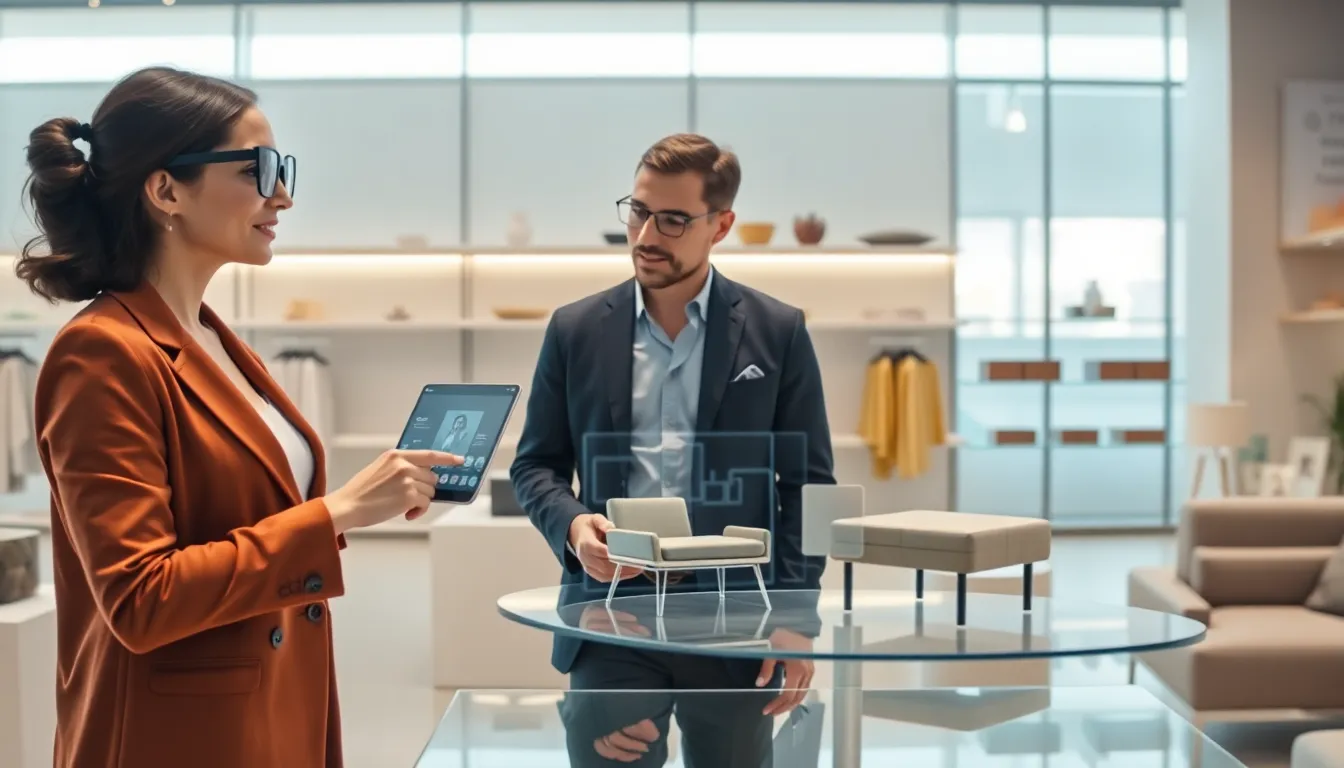Imagine walking into a store and seeing virtual displays that help you visualize how furniture fits in your living room or how that new jacket looks on you without trying it on. Welcome to the world of Augmented Reality (AR) in commerce. It’s not just a buzzword floating around in tech circles: it’s revolutionizing the shopping landscape in ways that seem straight out of a sci-fi movie. This article dives deep into AR’s transformative power within retail, exploring its applications, challenges, and future trends with a hint of humor and a hefty dose of insight. Let’s embark on this tech-savvy shopping adventure.
Table of Contents
ToggleUnderstanding Augmented Reality

Augmented Reality (AR) merges the real and digital worlds by layering digital information onto our physical surroundings. Picture a world where you see a digital layer overlaid on top of reality via your smartphone or AR glasses. Unlike Virtual Reality (VR), which isolates users from the real world, AR enhances what’s around us, bringing a fresh perspective to everyday experiences.
At its core, AR operates through sophisticated tech, think computer vision, simultaneous localization and mapping (SLAM), and depth tracking. This technology allows devices to recognize environments and superimpose digital images accordingly. The result? A seamless blend where products come alive with interactive features. This innovative interaction has set the stage for AR’s use in commerce, paving the way for unforgettable consumer experiences.
Applications of Augmented Reality in Retail
Enhancing Customer Experience through AR
AR isn’t just a gimmick: it indeed redefinies how consumers engage with brands. One primary application is virtual try-ons. Take clothing retailers, for instance. Instead of rummaging through racks, shoppers can now visualize how outfits look on them through AR mirrors or mobile apps. The cycle of trying, buying, wearing, regretting, and returning is becoming more efficient and enjoyable. Now, who doesn’t want to avoid the awkwardness of squeezing into that too-small dress?
Also, AR helps consumers envision products in their homes before making a purchase. For example, IKEA’s app allows you to visualize furniture in your space via your smartphone camera. This functionality eliminates buyer’s remorse by helping shoppers make informed choices, eventually increasing brand trust and loyalty.
Case Studies: Successful AR Implementations
Several brands have successfully adopted AR, setting benchmarks for others to follow. Sephora, the beauty giant, introduced an AR feature that lets users virtually apply makeup products through their mobile devices. This not only boosts consumer confidence but also reduces returns, as customers are happier with their selections.
Similarly, Nike’s use of AR aids in personalized shopping. Their mobile app allows customers to scan shoes and access detailed information using AR. It’s all about creating an enriching experience that makes shoppers feel valued. By integrating cutting-edge technology, brands can truly stand out in a competitive marketplace.
Challenges of Integrating AR in Commerce
While the potential of AR in retail is enormous, it isn’t all smooth sailing. One significant hurdle is the cost of implementation. Developing AR applications can require significant investment in technology and talent that some companies may not be ready to commit to.
Besides, there’s the issue of user adoption. Many consumers may still be skeptical about the accuracy and reliability of AR features. If a virtual try-on shows a remarkably different color or fit from the actual product, brand trust can erode quickly. Educating consumers on how to use AR features effectively is essential in overcoming this barrier.
Finally, tech compatibility poses another challenge. Not all smartphones or devices support advanced AR functionalities. Businesses must ensure a broad compatibility range to maximize user engagement. Without addressing these challenges, companies could miss out on harnessing the full potential of AR.
Future Trends of Augmented Reality in Merchandising
As technology advances, so will the applications of AR in commerce. One exciting trend is the rise of in-store AR experiences. Imagine walking through a grocery store, scanning items with your phone, and receiving personalized discounts or promotions based on your shopping history. This level of personalization could redefine in-store shopping as we know it.
Also, as social media platforms continue integrating AR, think Snapchat filters, retailers might leverage these platforms to create interactive ad campaigns that engage users in innovative ways. Picture an Instagram filter that allows users to see themselves wearing a new clothing line.
Finally, more brands are likely to employ AR for enhanced storytelling. Creating immersive brand experiences can lead to stronger emotional connections and increased customer loyalty. AR can turn shopping into an adventure, where consumers journey through narratives that make the act of buying feel truly special.


